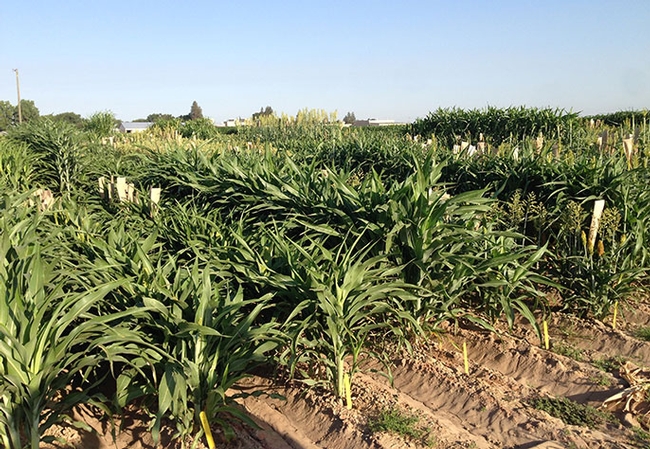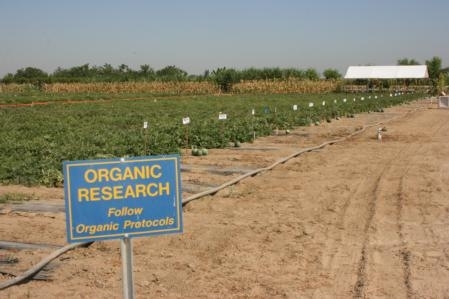Posts Tagged: Kearney
Microbes associated with plant roots could be a key to helping plants survive drought
As sorghum plants cope with drought conditions, the plants' roots and adjoining microbial communities are communicating in a chemical language that appears to improve the plants' chances under water stress.
“It's amazing,” said Peggy Lemaux, UC Cooperative Extension specialist. “We know there are lots of microbes in the soil and, for the most part, ones in the surrounding soil stayed the same under drought conditions. We only saw changes in those microbes closely associated with the roots.”
The role of drought in restructuring the root microbiome was the first published discovery to come out of a sweeping drought research project underway since 2015 in the fields at UC Kearney Research and Extension Center in Parlier. The five-year study, funded with a $12.3 million grant from the Department of Energy, aims to tease out the genetics of drought tolerance in sorghum and its associated microbes. Using sorghum as a model, scientists hope the research will help them understand and improve drought tolerance in other crops as well.
The new research results from the lab of USDA's Devin Coleman-Derr at UC Berkeley, published April 16, 2018, in the Proceedings of the National Academy of Sciences, document the fate of microbes associated with sorghum roots under three distinct irrigation regimens. Because the San Joaquin Valley generally sees no rain during the growing season, it is the ideal place to mimic drought conditions by withholding irrigation water.
All plots received a pre-plant irrigation to initiate growth. In the control plots, sorghum was irrigated normally, with weekly watering through the season. In the plot simulating pre-flowering drought stress, the plants received no additional water until flowering, about halfway through the season. The third treatment was watered normally until it flowered, and then water was cut off for the rest of the season.
Beginning when the plants emerged, the scientists collected samples from each plot on the same day and time each week for 17 weeks. In a mini, in-field laboratory, roots, rhizosphere (zone surrounding the root), leaves and soil samples from 10 plants in each plot were immediately frozen and transported to Berkeley, where they were disseminated to collaborators, who investigated the plant and microbial responses at the molecular level.
“When a sorghum plant is subjected to drought, it starts sloughing off metabolites, nutrients and amino acids from the roots. The compounds appear to communicate to the neighboring microbial community that the plant is under stress,” Lemaux said. “That selects out a certain population of microbes. Certain types of microbes increase, others go away. When you add water back, the microbial community returns to its pre-drought population in just a few days.”
The researchers cultured two specific microbes that were enriched in the rootzone under drought conditions. They coated sorghum seeds with the microbes and planted them under drought conditions in a growth chamber. This treatment encouraged the plant to grow more roots.
“The microbes appear to improve plant growth during drought,” Lemaux said. “Those microbes appear to be helping plants survive drought. We didn't know that was happening before we got these results.”
Lemaux said the research might lead to future field use of the research breakthrough.
“A lot of companies are interested in the microbiome,” she said. “Some are already selling microbes to coat seeds.”
Organic symposium proceedings now available
Summaries of presentations from the 2016 Organic Agriculture Research Symposium (OARS) held in Pacific Grove are now available online at http://eorganic.info/node/16778. Many of the workshops and keynote presentations were recorded live and may be viewed via the eOrganic YouTube channel.
The event, which was co-sponsored by the Organic Farming Research Foundation and UC Kearney Agricultural Research and Extension Center, covered topics ranging from soil health, seeds, plant breeding, and biological control, to biodiversity, economics, and livestock — all with a focus on organic production.
“We are making these presentations available free online to extend the reach of all the valuable information shared at the symposium,” said Jeff Dahlberg, director of the UC Kearney Agricultural Research and Extension Center. “We're now planning the 2017 symposium and it will build on the cutting edge research shared by scientists this year.”
In the opening address, president of Organics International, André Leu, said organic agriculture offers the promise of a future to produce and distribute food and other farm products in a healthy, economically sound, truly sustainable and fair way. He called the current state of organic agriculture “Organic 3.0.”
“This is a concept we put out a year ago and it is resonating around the world,” Leu said. Organic 1.0 dates back to the 1920s and represents organic farming founders and visionaries, he said. Organic 2.0, beginning in the 1970s, represents the establishment of private standards, public regulations and global recognition. The current stage of organic farming is a time for market reinvention, widespread conversion and performance improvement.
Financial support for the 2016 OARS was provided by the USDA National Institute for Food and Agriculture Organic Research and Extension Initiative and the Gaia Fund.
"The OARS conference was very successful in bringing national and international scholars and farmers together to present findings about the latest research and how it is advancing organic farming and ranching," said Diana Jerkins, OARF research director. "OFRF will continue to encourage and participate in events such as these to ensure current research, education, and extension efforts are widely disseminated."
Organic Farming Research Foundation is a non-profit foundation that works to foster the improvement and widespread adoption of organic farming systems. OFRF cultivates organic research, education, and federal policies that bring more farmers and acreage into organic production.
The UC Kearney Agricultural REC is one of nine UC Agriculture and Natural Resources research and extension centers across the state of California. Ten acres at the 330-acre center are certified organic and available for organic research.
Drone technology on display at UC research center
The UC Desert Research and Extension Center hosted a workshop for employees and local stakeholders on potential uses for drone technology in agriculture, reported Edwin Delgado in the Imperial Valley Press.
“The intent of this workshop is to start bringing the knowledge about unmanned aerial systems to the University of California Agricultural and Natural Resources division and the public at large,” said Sean Hogan, coordinator of Informatics Geographic Information Systems for UC ANR. “There is so much curiosity about it right now, it's a growing industry and there is a lot of concern and controversy about the misuses on it.”
The article said the UC system now has the green light to begin using drones. Hogan is holding workshops throughout the state to share his expertise with UC ANR employees and members of the community.
Desert Research and Extension Center director Jairo Diaz said the workshop was important because participants were able to see a demonstration of how the technology works and how it can be applied to the projects and research they are currently working on.
“These workshops that give growers and stakeholders can use in the area are very important because tech like this can help in the near future help find out different types of issues on the field like management of nutrients, water and find out to improve management of field,” Diaz said.
At the UC Kearney Agricultural Research and Extension Center last week, technicians tested a drone that will be used throughout the summer to collect growth data on 600 varieties of sorghum begin produced under different irrigation regimens. With imaging and lidar, the drone collects information on leaf area and biomass in half an hour that would take a full day for a person in the field.
Read more about the sorghum research at Kearney here.
Phase 3 complete in Kearney solar energy project
JKB Energy has completed three phases of a solar energy project at UC ANR Kearney Agricultural Research and Extension (KARE) Center in Parlier. The system eliminates thousands of pounds of emissions and saves the center tens of thousands of dollars in energy costs annually, according to a JKB Energy news release. Kearney is one of nine research and extension centers located throughout the state that are part of the University of California Division of Agricultural and Natural Resources (UC ANR).
JKB Energy has worked with Robert Ray, superintendent of the UC ANR KARE physical plant, to maximize their bill offset program. Since 2012, when the program started, UC ANR KARE has steadily cut its energy costs.
After the completion of the final phase, projected for 2016, the center's “postharvest” meter's annual electricity costs will be offset by approximately 96 percent. Postharvest research is science conducted after a crop has been harvested and includes such processes as of cooling, cleaning, sorting, and packaging and how these might affect the quality of stored fruits and vegetables.
According to JKB Energy, over 25 years, this project will eliminate the equivalent of:
- 473,735 pounds of carbon dioxide, the leading greenhouse gas
- 1,520 pounds of nitrogen dioxide, which creates smog
- 1,376 pounds of sulfur dioxide, which causes acid rain
- 94 pounds of particulates that cause asthma
- 770,814 miles driven in an average car
The system is the equivalent of taking 2.5 cars off the road for 25 years, or planting 4.1 acres of trees.
UC president Janet Napolitano visits Kearney REC
On her way to Kearney, Napolitano viewed California cropland, rivers and reservoirs that have been impacted by three years of drought.
"There are areas that clearly are being allowed to remain fallow due to drought, there are hills that should be green that are brown, and there are reservoirs where you can clearly see the water mark," she said. "Through the extension service we will work with growers throughout the state to manage this the best way possible."
Ryan Jacobsen, Fresno County Farm Bureau executive director, said growers' relationship with the UC's extension field offices has historically played a big role in the success of the Valley's agricultural economy, Furfaro reported. Advances made in the lab quickly make it to the farms, he said, in large part because of how well regional centers work with farmers.
Alec Rosenberg of the UC Newsroom filed a detailed account of President Napolitano's visit to the San Joaquin Valley. The article said she met with the President's Advisory Commission on Agriculture and Natural Resources to discuss how to engage all 10 campuses in making UC the "go-to" institution in the world for all issues related to food, including sustainability and nutrition.
Napolitano toured the Kearney REC, where she learned about UC's role in helping establish a blueberry industry in the San Joaquin Valley, efforts to preserve the safety of pistachios and other nut crops, and work underway in the center's mosquito lab.
Napolitano noted that she recently made ANR vice president Barbara Allen-Diaz a direct report to her because agricultural issues matter to California and the world, Rosenberg reported.
“It's great to see the incredible depth and breadth of California agriculture, and show the link between UC research and extension and the development of agriculture in the state,” said Allen-Diaz, who accompanied Napolitano on the tour.
Additional coverage:
Napolitano, UC's Kearney center focus on drought relief
Benjamin Genta, UCLA Daily Bruin






